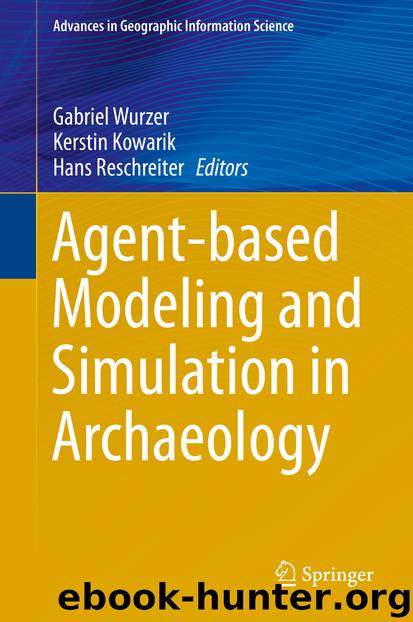Agent-based Modeling and Simulation in Archaeology by Gabriel Wurzer Kerstin Kowarik & Hans Reschreiter

Author:Gabriel Wurzer, Kerstin Kowarik & Hans Reschreiter
Language: eng
Format: epub
Publisher: Springer International Publishing, Cham
6.4.3 Solving the Dilemma of Self-fulfilling Prophecies
The two previous topics proof that some models cannot be simplified or split in simpler simulations. As a consequence, the results can be more complex to understand and justify. Parallel to these issues there is another one that, in our opinion, seems to be the most important issue of state of the art archaeological simulations: the definition of behaviors.
The vast majority of published ABMs are based on the classic SugarScape model by Epstein and Axtell (1996). The model consists of a discrete world, defined as a finite bi-dimensional matrix, where a set of agents interact between them as well as with the environment. This behavior is defined as a list of rules; if one condition applies, a simple behavior is executed (e.g. if there is no food the agent will move to the adjacent place with more resources). In other words, the decision-making process of the agent is wired, as its choices are completely predefined. As a consequence it is incapable of finding solutions and reacting to conditions not devised by the modeler. This is a weakness of the methodology if we think that the interest on ABMs is precisely the emergence of large scale behaviors from the interaction of these simple rules. In theory these behaviors should not be explicitly defined in the original model, but as we said behavior is predefined, so there exist an important thread of circular explanations (Macal and North 2010).
Moreover, if everything in an ABM is related to the agent’s behavior, why is it not analyzed like a parameter? Behavior is arbitrarily defined based on archaeological assumptions, so it should also be explored to ensure scientific quality. Most models do not face this issue, so we are not really sure if different behaviors (even slight variations) affect the observed outcome as no sensitivity analysis is performed to study it.
The consequence of this problem is that critiques against ABM focus on the fact that they are self-fulfilling prophecies: emergent traits are not related to the problem, but to the way it was programmed, and if we can take a look at the code, we will learn the implicit or explicit assumptions the modeler introduced in order to achieve the final outcome.
The solution of this issue is critical for the future of ABM. For simple models it can be argued that the assumptions are less important, because such models can be replicated and understood without problems. Theory building models guarantee the scientific quality, as the number of parameters is small and behavior is so simple that the emergence of non-expected behavior can be understood with proper analysis.
The same cannot be said about hypothesis testing simulations. They are usually more complex because their goal is to understand realistic scenarios. For this reason these models create agents with several traits and a large list of conditions and rules, as simpler agents would not be able to take decisions based on the amount of data being used. In the end it will become
Download
This site does not store any files on its server. We only index and link to content provided by other sites. Please contact the content providers to delete copyright contents if any and email us, we'll remove relevant links or contents immediately.
Sass and Compass in Action by Wynn Netherland Nathan Weizenbaum Chris Eppstein Brandon Mathis(8808)
Autodesk Civil 3D 2024 from Start to Finish by Stephen Walz Tony Sabat(7337)
Mathematics for Game Programming and Computer Graphics by Penny de Byl(7247)
Taking Blender to the Next Level by Ruan Lotter(7046)
Express Your Creativity with Adobe Express by Rosie Sue(6842)
Hands-On Unity 2022 Game Development - Third Edition by Nicolas Alejandro Borromeo(6482)
Hands-On Unity 2022 Game Development by Nicolas Alejandro Borromeo(5188)
Unreal Engine 5 Character Creation, Animation, and Cinematics by Henk Venter & Wilhelm Ogterop(4079)
Going the Distance with Babylon.js by Josh Elster(4038)
Squeaky Clean Topology in Blender by Michael Steppig(3922)
Mastering Graphics Programming with Vulkan by Marco Castorina & Gabriel Sassone(3918)
Adobe Illustrator for Creative Professionals by Clint Balsar(3757)
Drawing Shortcuts: Developing Quick Drawing Skills Using Today's Technology by Leggitt Jim(2996)
Unreal Engine 5 Character Creation, Animation, and Cinematics by Henk Venter Wilhelm Ogterop(2923)
Rapid Viz: A New Method for the Rapid Visualization of Ideas by Kurt Hanks & Larry Belliston(2833)
The 46 Rules of Genius: An Innovator's Guide to Creativity (Voices That Matter) by Marty Neumeier(2796)
Learn Qt 5: Build modern, responsive cross-platform desktop applications with Qt, C++, and QML by Nicholas Sherriff(2423)
Fusion 360 for Makers by Lydia Sloan Cline(2308)
Hands-On Neural Networks with Keras by Niloy Purkait(2227)
